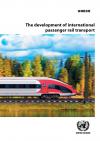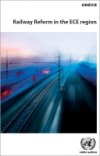Publications
Displaying Results 21 - 40 of 148
- Pусский
Международные железнодорожные пассажирские перевозки имеют фундаментальное значение для перемещения людей через границы в регионе ЕЭК. Их центральная роль была подчеркнута в резолюции № 264 Комитета по внутреннему транспорту. Пандемия COVID-19, помимо негативных экономических последствий, которые еще предстоит преодолеть, дает возможность пересмотреть роль железнодорожного транспорта в регионе
- English
International rail passenger transport is of fundamental importance to the movement of people across borders in the ECE region. Its central role was highlighted in Inland Transport Committee Resolution No. 264. The COVID-19 pandemic offers, beyond its negative economic impacts that remain to be recovered from, the opportunity to reconsider the role of rail transport in the ECE region and further
- Français
L’ADR, fait à Genève le 30 septembre 1957 sous l'égide de la Commission économique des Nations Unies pour l'Europe, est entré en vigueur le 29 janvier 1968.
Cet Accord est destiné à accroître la sécurité du transport international de marchandises dangereuses par route. Ses annexes A et B imposent les conditions dans lesquelles les marchandises dangereuses, lorsqu'elles ne sont pas interdites,
- English
Adopted on 30 September 1957 in Geneva under the auspices of the United Nations Economic Commission for Europe (UNECE), the ADR entered into force on 29 January 1968.
This authoritative Agreement is intended to increase the safety of international transport of dangerous goods by road. Its Annexes A and B contain the technical requirements for road transport, i.e. the conditions under which
- English
As part of the ongoing activities of the Working Party on Rail Transport (SC.2) a workshop titled “Making rail freight more competitive: The coordinated development of the rail network with a focus on how to work together at the government and sectoral levels on the EATL” was held at the seventy-third session of the Working Party.Over 60 participants from national administrations,
- English
ST/SG/AC.10/11/Rev.7
Sales No. E.20.VIII.1
ISBN 978-92-1-130394-0
eISBN 978-92-1-004503-2
Languages: E, F, (A, C, R, S forthcoming)
How to order this publication?
This publication is also available online for free (download).
The "Manual of Tests and Criteria" contains criteria, test methods and
- English
These recommendations have been developed in the light of technical progress, the advent of new substances and materials, the exigencies of modern transport systems and, above all, the requirement to ensure the safety of people, property and the environment. They are addressed to governments and international organisations concerned with the regulation of the transport of dangerous goods. The
- English
The GHS addresses classification of chemicals by types of hazard and proposes harmonized hazard communication elements, including labels and safety data sheets. It aims at ensuring that information on physical hazards and toxicity from chemicals be available in order to enhance the protection of human health and the environment during the handling, transport and use of these chemicals.
The GHS
- English
As part of the ongoing activities of the Working Party on Rail Transport (SC.2) a workshop titled “Making the railways of the future for the region” was held at the seventy-second session of the Working Party.Over 65 participants from national administrations, international organizations, non-governmental organizations and the private sector discussed, over a number of sessions, the role of
- English
The European Agreement concerning the International Carriage of Dangerous Goods by Inland Waterways (ADN) done at Geneva on 26 May 2000 under the auspices of the United Nations Economic Commission for Europe (UNECE) and the Central Commission for Navigation on the Rhine (CCNR) has been in force since February 2008. The Agreement currently has eighteen Contracting Parties. The Regulations
- English
Adopted on 30 September 1957 in Geneva under the auspices of the United Nations Economic Commission for Europe (UNECE), the ADR entered into force on 29 January 1968. This authoritative Agreement is intended to increase the safety of international transport of dangerous goods by road. Its Annexes A and B contain the technical requirements for road transport, i.e. the conditions under
- Pусский
This study on railway reform in the ECE Region looks at the history of railway reform within its member States and looks at how it has been implemented through a number of examples, highlighting that railway reform across the ECE region has taken different forms in terms of institutional structure, market participants and development of the sector.
- Français
This study on railway reform in the ECE Region looks at the history of railway reform within its member States and looks at how it has been implemented through a number of examples, highlighting that railway reform across the ECE region has taken different forms in terms of institutional structure, market participants and development of the sector.
- English
This study on railway reform in the ECE Region looks at the history of railway reform within its member States and looks at how it has been implemented through a number of examples, highlighting that railway reform across the ECE region has taken different forms in terms of institutional structure, market participants and development of the sector.
- English
The GHS addresses classification of chemicals by types of hazard and proposes harmonized hazard communication elements, including labels and safety data sheets. It aims at ensuring that information on physical hazards and toxicity from chemicals be available in order to enhance the protection of human health and the environment during the handling, transport and use of these chemicals.The GHS
- English
These recommendations have been developed in the light of technical progress, the advent of new substances and materials, the exigencies of modern transport systems and, above all, the requirement to ensure the safety of people, property and the environment. They are addressed to governments and international organisations concerned with the regulation of the transport of dangerous goods. The
- English
The European Agreement concerning the International Carriage of Dangerous Goods by Inland Waterways (ADN) done at Geneva on 26 May 2000 under the auspices of the United Nations Economic Commission for Europe (UNECE) and the Central Commission for Navigation on the Rhine (CCNR) has been in force since February 2008. The Agreement currently has eighteen Contracting Parties.The Regulations
- English
Adopted on 30 September 1957 in Geneva under the auspices of the United Nations Economic Commission for Europe (UNECE), the ADR entered into force on 29 January 1968.This authoritative Agreement is intended to increase the safety of international transport of dangerous goods by road. Its Annexes A and B contain the technical requirements for road transport, i.e. the conditions under which
- English
ST/SG/AC.10/11/Rev.6Sales No. E.15.VIII.3ISBN 978-92-1-139155-8Price: US$ 125Languages: E, F, S (A, C, R forthcoming)How to order this publication?This publication is also available online for free (download).The Manual of Tests and Criteria contains criteria, test methods and procedures to be used for classification of
- English
The GHS addresses classification of chemicals by types of hazard and proposes harmonized hazard communication elements, including labels and safety data sheets. It aims at ensuring that information on physical hazards and toxicity from chemicals be available in order to enhance the protection of human health and the environment during the handling, transport and use of these chemicals.The GHS

















